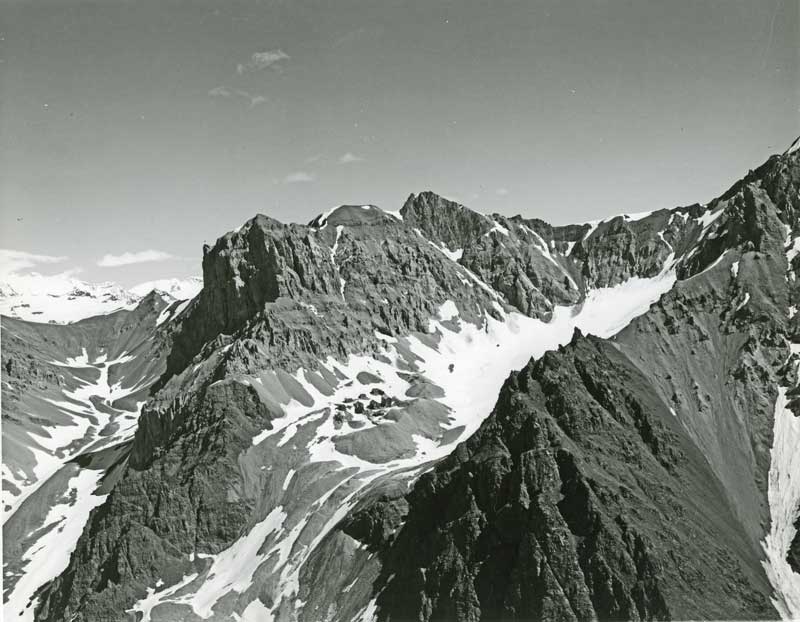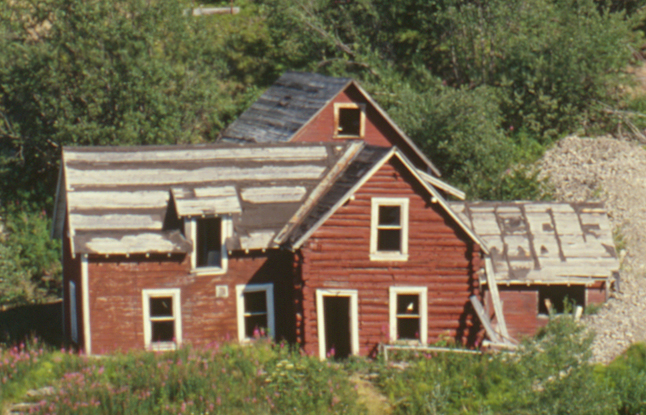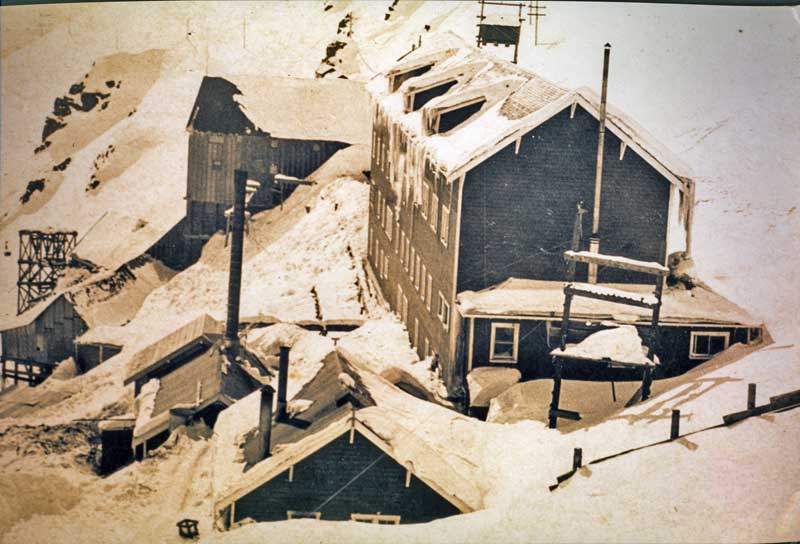 |
| Abandoned Jumbo Mine viewed from the air in 1955 --AMHA, Ward Wells Collection |
Subtle changes were taking place at Kennecott, which were obvious only to the engineers and their managers in the far away offices in downtown Seattle and at 120 Broadway in New York. Kennecott President Stephen Birch visited Kennecott for the last time in 1924 to evaluate the future of the Bonanza and the other mines. The inescapable conclusion was that all the major ore bodies had already been discovered and that the mine was now operating off of rapidly shrinking reserves. Even at that, the ore bodies were so extensive that the decline would not be obvious for years. Some never saw it at all. The consulting engineers estimated the remaining tonnage would take another eight years to extract, given a continued high rate of production.
From 1916 through 1925 the production was such that an ore train was required to operate six days a week, pulling at least thirty ore cars on each consist. The conditions under which the railroad had to operate required very high maintenance, but even so there were many weeks out of each year when the railway was inoperable. In most cases this was either due to extreme snow-drifting along the first hundred miles of the railroad or because the crossing at Chitina had gone out. The line was subject to frequent wash-outs, collapse of trestles and rail beds, avalanches, and problems with the tunnels.
The constant demand on the railroad had taken its toll on the track bed, the trestles and on aging rolling stock. The CRNW simply could not continue to operate as it had in the past without major investments to upgrade the system. Stephen Birch had already ruled out this possibility.
Had Birch and Stannard had their way, the mine would have closed by 1930 when they shut down the Beatson and Girdwood Mines on LaTouche Island. However, Alan Bateman, the senior mining consultant who replaced Wesley Dunkle, convinced the company not to purse a high speed withdrawal. Bateman preferred a twelve-year plan of retreat, not because the company was operating an aging railroad, but because he wanted more time for additional exploration. The consulting engineer wanted to be certain that every possibility of finding new ore bodies had been thoroughly exhausted.
 |
| The abandoned Kennecott general office in the ghost town of Kennecott in 1981 -Historic American Engineering Record |
In the end, it all became a matter of weighing the cost of continuing the operation of an aging and obsolete railroad system against the cost of extending the life span of the Bonanza, Jumbo and Mother Lode mines.
The Copper River and Northwestern Railway was never completed as intended. The temporary trestles made up nearly fifteen percent of the track grade from Cordova to Chitina. It remained that way for the twenty-seven years of railroad operation. Permanent steel bridges, contemplated to replace the larger wooden trestles, including the four-span Copper River crossing at Chitina, existed only as an engineering drawings, never to be built.
All the short-term fixes of those early years became permanent when it became apparent that the CRNW would never be anything more than a large mining railroad. Kennecott, the owner of the CRNW, decided it made more sense to maintain their aging trestles and other obsolete railroad features than to replace them. Unfortunately, no preservatives were used in the original trestle bents or the wooden ties. The company operated almost on a year-by-year basis, refusing to invest more than the absolute minimum amount of money required into their antiquated and increasingly inadequate system.
Large sections of the railway ran over old glacial remnants that were subject to severe melting, similar to the vast expanses of permafrost. None of the engineers understood how to build in such country. The most severe permafrost conditions existed around Strelna, but the problem extended along most of the Chitina Local branch from Chitina to Kennecott.
The snowsheds along Abercrombie contained heavy timber construction that deflected enormous snow loads, but these were eventually destroyed by the sheer weight of the overburden. They were not replaced after their destruction by heavy snows in 1931, the last year of winter railway service.
Railroad ties and trestle bents were constantly being replaced, while hundreds of thousands of cubic yards of gravel were dumped to stabilize other sections of the remote line.
No one knew how long the system could be kept patched together. The line was only one of a handful of sub-arctic railroads in existence. The engineers could only present expensive suggestions to fix on-going problems. What was clear was that it would always take up to 250 men to run the unproductive, money-losing railroad--about the same number required to run all the Kennecott mines at high production levels.
 |
| Bonanza Mine --Simpson files |
It was the lingering possibility of finding additional rich ore which finally won out. Birch reluctantly opted for an extended plan of mining retreat in 1925. Because of this decision, the gradual exhaustion of the mines would go unnoticed to all but a few. A subtle withdrawal served the interests of Kennecott, who did not want to be left at the mercy of hostile labor elements who might seize on the opportunity to press for huge concessions. E.T.Stannard was prepared to shut down immediately and permanently if faced with a massive unionization of the mines and mill. The Great Man who built his career on Kennecott would never return. Without his personal interest, the milling and railway system began to crumble as corporate resources went elsewhere. Although Birch died three years after the end of Kennecott, Alaska, he was irrevokably linked with the remote mountain railroad and mine system and of Kennecott’s interest in the entire territory. He was the life force of Kennecott and the CRNW Railway. When Birch lost interest in the mine, the Alaskan properties became a doomed piece of a much larger Kennecott Corporation that had its genesis in the Wrangell Range.
No comments:
Post a Comment